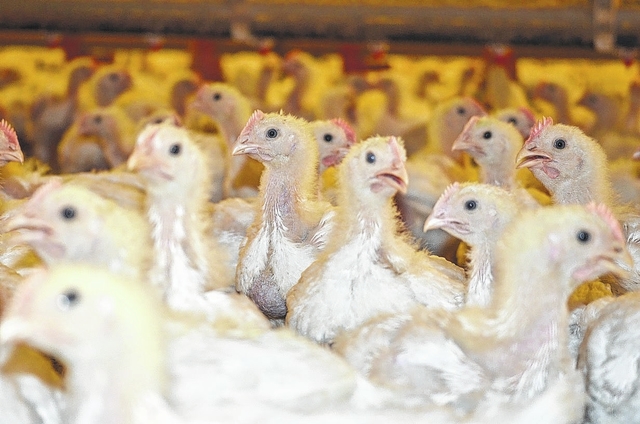ROCKINGHAM — A highly pathogenic strain of avian flu closely related to Asian bird flu virus H5N1 that mutated and then sickened more than 700 people across 15 countries is expected wreak havoc in the state’s poultry farms early this fall.
Influenza A type H5N2 was last found among egg-producing birds in Iowa and turkeys in Minnesota on June 9, but the threat is far from over since this virus has been traced to migrating water fowl, according to the North Carolina State Department of Agriculture.
Local poultry farmers are taking the threat seriously.
“When the ducks and geese start migrating south and fly over, it’s going to be very much a concern,” said Jared Gainey, who raises chickens outside Ellerbe for Mountaire Farms.
He said farmers are trying to be proactive and figure out a plan of action in the event of an outbreak.
“In Canada and down through the Midwest, it’s already hitting,” he said. “It’s not a matter of if it’s going to strike it’s a matter of when.”
Gainey, who is also on the Richmond County Soil and Water Conservation Board, has 120,000 chickens per flock at one farm and 81,200 per flock at another, and has an average of 4.5 flocks per year. An outbreak of the virus could result in a 90 percent loss.
He said farmers should double-check with their insurance companies and make sure they’re covered.
Another proactive step is developing a plan to dispose of dead birds following an outbreak. Gainey said composting seems like the best solution.
Richard Goforth, regional area specialized agent for poultry for the state cooperative extension, said North Carolina has no current reported infections, but as birds begin to migrate south from the Yukon and regions of Canada the virus could get out of hand rapidly.
“Once signs appear such as watery eyes and runny beaks and general things you think of as being signs of a cold, even if it’s a single chicken in a poultry house, this would require reporting,” Goforth said.
Steps a poultry farmer would need to take include immediate reporting to the state department of agriculture.
“They’d send people to the farm to begin testing the bird for the presence of the strain,” Goforth said. “The state has categorized this as highly pathogenic, and that means it spreads rapidly and has a very high mortality rate. This strain has a more than 50 percent mortality rate among infected birds.”
If a bird in a poultry house is found to be infected, the situation degenerates quickly.
“Because it’s a reportable disease, the next step would be depopulation of the chicken house as soon as possible,” Goforth said. “Depopulation does mean to euthanize those birds. It’s humane and keeps the birds from suffering a long, slow and painful death from the virus. And it has to be done.”
Last month, state officials announced a ban on live poultry shows and sales from Aug. 15-Jan. 15. In addition, no birds will be allowed to be shown in agricultural fairs across the state.
Goforth emphasized that this strain is not the same as the Asian flu people are more familiar with that has at times infected humans.
“It is theoretically possible there could be a mutation,” he said. “But our workers wear respiration masks and gloves and are decontaminated after entering poultry houses to prevent the spread. Currently as far as people coming down with this virus, the CDC ranks it as low risk.”
Following the depopulation of an infected flock, Goforth said a perimeter of nearly two miles surrounding the farm are quarantined by the state department of agriculture. The entire quarantined area is scouted by people sent from the state to look for signs of wild birds who may also be infected.
“Other farms within the quarantined area are tested before birds got to market,” he said. “The whole process — from the time the first infection is reported to the time depopulation and decontamination are completed — would take a minimum of six weeks.”
That could result in catastrophic losses for farmers, and consumers would see the prices of eggs and poultry soar in grocery markets.
“There is a USDA Livestock Indemnity Program they call LIP,” Goforth said. “It helps with some of the costs. It’s not much but it does help pay for the value of the flock. But it depends on that pot of money being there. As far as I know there is no insurance company that offers disease insurance for birds.”
Reach reporter Melonie McLaurin at 910-817-2673 and follow her on Twitter @meloniemclaurin.

